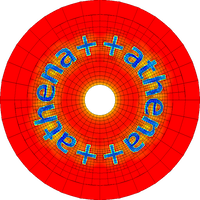Simulation gallery
Science Highlights
 Below are Athena++ simulations contributed by the workshop attendees and taken from either published research or ongoing projects.
Below are Athena++ simulations contributed by the workshop attendees and taken from either published research or ongoing projects.
Simulations from published research
Cloud coalescence simulations
Contributed by Tim Waters (LANL) ADS link
Description:
Simulation showing that two spatially well-separated 'pre-existing' clouds will coalesce - without any gravity!
The main image is a density map showing the full domain, while the lower panels zoom-in on the rectangular region.
The bottom panel is a map of vorticity and corresponds to the lower colorbar.
We refer to the 'dark spots' inside the clouds in these simulations as entrained vortex bubbles. They are underdense pockets of high vorticity gas that form at the cloud interfaces and then maintain their structure as they propagate deep inside the cloud. More simulations from this study are presented here.
Clustered supernovae drive powerful galactic winds after superbubble breakout
Contributed by Drummond Fielding (Flatiron) ADS link
Description: These movies show the expansion and breakout of a super-bubble in a turbulent, stratified patch of the ISM in a galactic disk with surface density Σg = 30 M pc^−2. The super-bubble is powered by 300 SNe that go off uniformly in time over 30 Myr, which corresponds to a progenitor stellar cluster mass of 10^4.5 M_solar. The movies show, from left to right, the temperature, number density, outflowing velocity (positive means leaving the box), and the cooling/heating rate (positive means losing energy). Prior to breakout, which occurs at ~2.5 Myr, more than 90% of the energy injected by the supernovae is lost to radiative cooling, but after breakout the amount of cooling drops by more than an order of magnitude and is carried away in a powerful wind.
Axisymmetric magnetothermal disk wind simulation
Contributed by Tim Waters (LANL) ADS link
Description: Here we solved the equations of ideal MHD with a source term for heating/cooling processes to model winds in X-ray binaries driven by both magnetic and pressure forces. Using Athena++, we first obtained a steady state thermal wind solution by running pure hydro simulations with heating/cooling. This solution served as our initial conditions, and we then re-evolved this thermal wind solution with a large scale magnetic field added. This magnetothermal solution can actually have slower velocities than the pure thermal wind because the field lines can channel the flow through a sub-optimal geometry for wind acceleration.
Simulations from ongoing research projects
Ppaque cloud irradiated by UV radiation
Contributed by Xiaoshan Huang (UVA)
Description:
This movie shows the evolution of an optically thick, cold cloud irradiated by UV radiation from intensive star forming region. Using Athena++ with radiation transfer module, we directly solve the time-dependent radiation transfer equation and hydrodynamic equations. We employ the cloud tracking technique, where the mass center of the cloud is fixed in the calculation domain. Uniform radiation flux from the left boundary impacts on the cloud, heats it as well as pushing on it. The cloud is compressed by radiation during acceleration. After reaching its volume minimum, the cloud re-expands. We found that unlike IR radiation, the UV radiation tends to cause the overheating of cold gas in a relatively short time. In this simulation, about half of cold gas is overheated within 0.13Myr. By the time the cloud is only accelerated to ~75km/s, which is well below the typical observed speed of cold molecular outflow.
Contributed by Matt Coleman (IAS)
Accretion Disk Bounday Layer
Description:
This is a 2D (cylindrical-polar) isothermal hydro simulation of an accretion disk boundary layer. Here the Keplerian velocity at the surface of the star (white dashed circle) is 9 times the sound speed. The left panel is the vortensity perturbation and the right panel is the wave action which allows for spiral density waves to be easily seen. Here we can see a single arm spiral rotating around the central accretor, which is a possible explanation for the dwarf nova oscillation.
Contributed by Matt Coleman (IAS)
Supernova shock hitting a White Dwarf
Description: This is a 3D hydro simulation of a self-gravitating white dwarf with a realistic EOS getting hit with a supernova shock. This simulation is designed to realistically model what happens to the donor in a mass transfering double white dwarf binary where the primary explodes as a type Ia SN.